| GISdevelopment.net ---> AARS ---> ACRS 1998 ---> Geology/Geomorphology |
The Methods of permian
limestones enhamcement by using of Remote Sensing
Floriz Khairi and Pegah
Izadpanah
Remote Sensing Group, Geological Survey of Iran
P. O. Box: 131851-1494 Tehran, Iran
Tel : (98)-21-9171, Fax: (98)-21-4009338
AbstractRemote Sensing Group, Geological Survey of Iran
P. O. Box: 131851-1494 Tehran, Iran
Tel : (98)-21-9171, Fax: (98)-21-4009338
Permian Limestones one important in Iran because, They consists of lateritic-Beuxite horizone, There fore these layers were looked over with new method and Remote Sensing studies. Thus, this study, is Concentrated in Saqez region.
Remote Sensing methods were useful in this region because, the field geological study in Saqez is very difficult alone and Remote Sensing Could help for Separating rock units.
Lateritic-Beuxite horizone in limestone lenses have a few dimension and their recognition by Remote Sen Sing was difficult, because they are limited analysis. We decided that first Campose a new way for Separating Permain limestones, fortunately separation between this unit and other limestones with using of Remote Sen Sing software facilities have given us good results. In this inverstigation we have used landsat TM data.
Introduction
Permian limetones in Iran Consistse of Continentual Sediments that these sediments change to laterite zones. (Image#1) is showing the bands No. 5 with Equalize stretches enhancement and the whole view of region.
There are various Rock units from Infracamberian to Miocent that are showed in image. 2. This image has been made of bands 5, 3, 1 from TM data.
There are two kinds of limestones in saqez Permian limestones and Oligocene limestones that our study more concentrated on them.
In image #3 permian limestones have been separated by red color. In image #4 Oligocene limestones have been Seperated by Green color.
Methods
We have used two main Methods: a and b.
a-1. Using of bands 5, 3, 1 in RGB channels and Equanalize Stretch Enhancement (image # 2). In this image permian limestones have characterized with yellowish white color.
Using of bands 7, 4, 2 in RGB channels and Equalize stretch Enhancement (image #5). In this image permian limestones have shown in dark violet.
a-2. Ratio (Image #6) This image is made of 5/3/1 as Red, 6/4/2 as green, 1/2/3 as blue (Image#7) This image is made of : 5/3/1 as Red, 4/2/1 as green, 7/5/1 an blue. In these images we can distinguish permian limestones from Oligocene limestone clearly.
Image #8 is made of : 3/1 as Red, 5 as green, 7 as blue. In this image permian limestones have shown in blue Color Complex with Red, red color in this image ignore with existing of iron oxide, because permian limestones consiste of Bauxite and Bauxite Consiste of iron Oxide.
a-3 Difference: (image#9) is made of difference between bands: 5-6 as red, 4-2 as green 3-1 as blue. This method is one of the best way for Separation limestones from eachother.
b. Signature Method: We used special method in Spectral reflection. We could separate permian limestone from Oligocene limestone. In this Method with composing diagrams from spectral refection of phenomena. In different bands we looked over brightness degrees of Various parts and showed them with the highest difference between and made special image. (image#10 and figure. 1).
As shown the highest degree for permian limestones (red line) is in band 5 and the lowest brightness degree is in band 2, beside the highest brightness degree for oligcene limestones (green line) is in band 4 and the lowest brightness degree is in hand 2. Image # 11 is made of : 5/2 as red (The highest and the lowest Brightness Degree is permian limestone), 4/2 as green (the highest and the lowest Brightness degree in Oligocene limestones) 3 as blue.
Summary
Using of different mathematical and statistical Methods (Ratio, difference) give us special images that permian limestones separated from other rock units specially oligicene limestones.
Seperated refection of phenomenas (signature method) shows that the highest brightness degree and the lowest brightness degree and the lowest brightness degree in permian limestones in various bands with oligocene limestone is completely different. As the whole brightness degree bands of permian limestones in various parts of image always were Same.
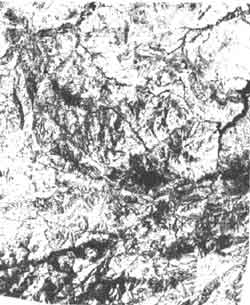
#1

#2

#3
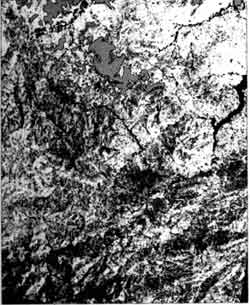
#4

#5
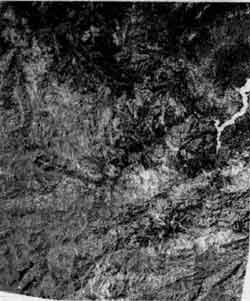
#6
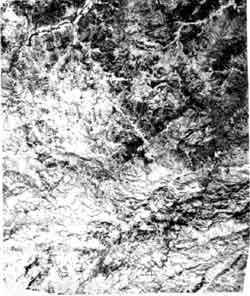
#7
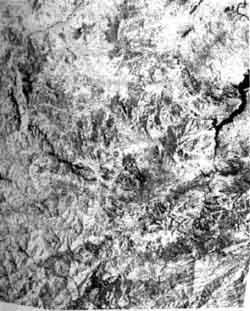
#8

#9
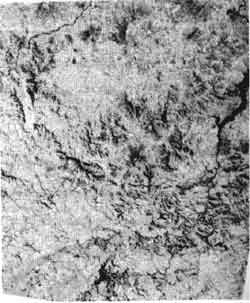
#10
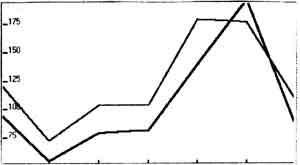
fig 1